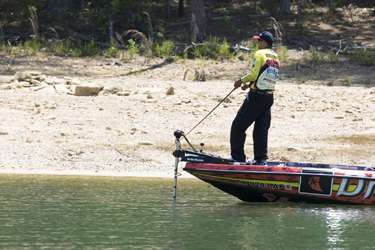
Navigating a flat smattered with stumps is no cakewalk, and fishing such a labyrinth isn’t much easier. However, for Elite Series pro James Niggemeyer, the springtime opportunity merits the challenge.
“Stumps, as well as flooded timber, give you reference points to cast to, and that helps you identify where the fish was sitting, rather than wondering if it was just sitting out there randomly,” he said. “Anytime you have a target to throw to, it’s easier to stay focused and to outline the pattern.
Stumps, says Niggemeyer, also reference the unseen. “This cover is like road markers. Anytime you have stumps or standing timber lining a creek channel or a drain, they funnel the fish [into and out of] the area.”
For stump field fishing, Niggemeyer likes stained water — preferably more in the stained-to-muddy range than stained-to-clear. He finds that the fish tend to roam more in clear water, so the stump targets prove less definitive. Sunshine’s good too, he notes. Light penetration always locks fish closer to cover, as the shadow lines make dandy ambush points. Light breezes and a small ripple on the surface is nirvana.
Niggemeyer’s standard stump field approach involves a trio of presentations.
Topwater: Strike King Spittin’ King (chrome Sexy Shad or bone) or a 3/8-ounce Strike King Tour Grade Buzzbait.
Shallow Crankbait: Strike King 4s square bill (chartreuse).
Flipping: Strike King Denny Brauer 4 1/2-inch flipping tube (black and blue, black neon or green pumpkin) and a 1/4-ounce tungsten bullet weight. Another option would be a 3/8- or 1/2-ounce Strike King Hack Attack jig (bluegill colors) with a Strike King Rage Craw trailer for maximum action.
Typically, he uses his moving baits to locate fish and then covers the spot with his bottom contact baits. A “fry ball next to a stump,” Niggemeyer said, presents a slam-dunk opportunity. Flipping a tube or jig into the nursery doesn’t set well with the buck bass on guard duty, and a topside invasion will really bring them out.
“If they’re guarding fry, you can run a topwater right across the stump and they’ll come up and crash it,” Niggemeyer said.
Of course, it’s not always lovely on the lake, and windy conditions are probably the biggest impediment for working a stump field. As Niggemeyer points out, boat handling becomes tricky in rough water, and that limits his realistic bait options. Moreover, while whacking a stump at trolling motor speed is unlikely to sink a bass boat, it will definitely announce your presence in a most intrusive manner.
“It makes it more difficult to make the pinpoint presentations that you can make with a tube or a jig,” Niggemeyer said. “You have to rely on your moving baits more, and, if you do that, you’ll have to move around a lot more and then you’re bumping into things more.”
In good conditions or bad, Niggemeyer knows that his time is best spent on the area of greatest fish concentration. For starters, all stumps are not created equal — some lean to one side, others are oddly shaped. Fish have their preferences, so pay attention to where the strikes occur.
Also note the bottom, Niggemeyer said. The word “flat” does not necessarily imply sameness, and he’s always looking for something that’ll attract and hold the fish.
“I want to find out if there are subtle rises or depressions — somewhere on that flat there is something different and the fish will be using that area more than the rest of the flat,” he said. “There may be a patch of grass in there or maybe there’s an area of harder bottom that the fish are using. There’s always something there under the surface that’s not obvious.”





